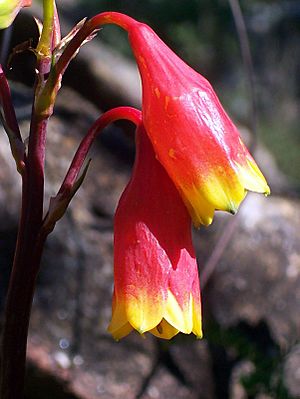Blandfordia nobilis facts for kids
Quick facts for kids Christmas bells |
|
|---|---|
 |
|
| Christmas Bell flowers at Berowra Valley Regional Park, Australia | |
| Scientific classification | |
| Genus: |
Blandfordia
|
| Species: |
nobilis
|
| Synonyms | |
|
Blandfordia nobilis var. imperialis W.Mill. & N.Taylor in L.H.Bailey |
|
The Blandfordia nobilis, often called Christmas bells, is a beautiful flowering plant. In the Cadigal language, it's known as gadigalbudyari. This plant grows only in New South Wales, Australia.
Christmas bells are a type of plant that lives for many years. They have narrow, grass-like leaves. Their flowers are large and hang down, shaped like bells or cylinders. These unique flowers are usually brownish-red with bright yellow tips. Blandfordia nobilis is one of four types of plants known as Christmas bells. You can find this specific kind growing along the coast and in the mountain ranges south of Sydney.
Contents
What Do Christmas Bells Look Like?
Christmas bells have strong, thick roots. These roots help the plant form big, long-lasting clumps. Their leaves are stiff and feel like grass. They can grow up to 75 centimetres (30 inches) long and are about 3 to 5 millimetres (0.1 to 0.2 inches) wide. Sometimes, the leaves have tiny teeth along their edges.
The plant's flowering stems can reach up to 80 centimetres (31 inches) tall. Each stem holds between three and twenty flowers. Each flower hangs on a small stalk. The flower itself is made of six parts (three sepals and three petals) that are joined together. This forms a tube shape, usually 20 to 30 millimetres (0.8 to 1.2 inches) long. The end of the flower has six pointed tips, which are about 5 millimetres (0.2 inches) long.
The flowers are typically brownish-red with yellow tips. Inside the flower tube, you'll find the stamens, which are the parts that produce pollen. Christmas bells usually bloom from late spring through summer. After the flowers, the plant produces a fruit. This fruit is a capsule, about 60 millimetres (2.4 inches) long, that holds the seeds.
Where Do Christmas Bells Grow?
You can find Blandfordia nobilis growing in specific areas of New South Wales. They prefer poor sandstone soils and wet, swampy places. These plants are found between the towns of Sydney, Milton, and Braidwood. In wet heathland areas, they often grow alongside other plants like sundews (Drosera) and Schoenus brevifolius.
Christmas Bells in Gardens
People have been interested in growing Christmas bells for a long time. Seeds of Blandfordia nobilis were sent to plant nurseries in England around the early 1800s. However, it took until 1818 for these plants to flower for the first time outside of Australia. It was sometimes confusing which exact species had flowered, as some plants called B. cunninghamii were actually B. nobilis.
Christmas Bells in Culture
The Blandfordia nobilis even inspired a Christmas song! In 1909, a popular Sydney songwriter named Joe Slater wrote "My Little Christmas Belle." The lyrics were by a Scottish entertainer, Ward McAlister. A copy of the song in the National Library of Australia even features a cartoon picture of the Christmas bell flower.
Images for kids
-
Christmas Bells by John Sims



